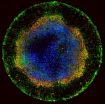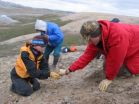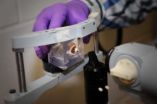(Press-News.org) Patients with Alzheimer's disease run a high risk of seizures. While the amyloid-beta protein involved in the development and progression of Alzheimer's seems the most likely cause for this neuronal hyperactivity, how and why this elevated activity takes place hasn't yet been explained – until now.
A new study by Tel Aviv University researchers, published in Cell Reports, pinpoints the precise molecular mechanism that may trigger an enhancement of neuronal activity in Alzheimer's patients, which subsequently damages memory and learning functions. The research team, led by Dr. Inna Slutsky of TAU's Sackler Faculty of Medicine and Sagol School of Neuroscience, discovered that the amyloid precursor protein (APP), in addition to its well-known role in producing amyloid-beta, also constitutes the receptor for amyloid-beta. According to the study, the binding of amyloid-beta to pairs of APP molecules triggers a signalling cascade, which causes elevated neuronal activity.
Elevated activity in the hippocampus — the area of the brain that controls learning and memory — has been observed in patients with mild cognitive impairment and early stages of Alzheimer's disease. Hyperactive hippocampal neurons, which precede amyloid plaque formation, have also been observed in mouse models with early onset Alzheimer's disease."These are truly exciting results," said Dr. Slutsky. "Our work suggests that APP molecules, like many other known cell surface receptors, may modulate the transfer of information between neurons."
With the understanding of this mechanism, the potential for restoring memory and protecting the brain is greatly increased.
Building on earlier research
The research project was launched five years ago, following the researchers' discovery of the physiological role played by amyloid-beta, previously known as an exclusively toxic molecule. The team found that amyloid-beta is essential for the normal day-to-day transfer of information through the nerve cell networks. If the level of amyloid-beta is even slightly increased, it causes neuronal hyperactivity and greatly impairs the effective transfer of information between neurons.
In the search for the underlying cause of neuronal hyperactivity, TAU doctoral student Hilla Fogel and postdoctoral fellow Samuel Frere found that while unaffected "normal" neurons became hyperactive following a rise in amyloid-beta concentration, neurons lacking APP did not respond to amyloid-beta. "This finding was the starting point of a long journey toward decoding the mechanism of APP-mediated hyperactivity," said Dr. Slutsky.
The researchers, collaborating with Prof. Joel Hirsch of TAU's Faculty of Life Sciences, Prof. Dominic Walsh of Harvard University, and Prof. Ehud Isacoff of University of California Berkeley, harnessed a combination of cutting-edge high-resolution optical imaging, biophysical methods and molecular biology to examine APP-dependent signalling in neural cultures, brain slices, and mouse models. Using highly sensitive biophysical techniques based on fluorescence resonance energy transfer (FRET) between fluorescent proteins in close proximity, they discovered that APP exists as a dimer at presynaptic contacts, and that the binding of amyloid-beta triggers a change in the APP-APP interactions, leading to an increase in calcium flux and higher glutamate release – in other words, brain hyperactivity.
A new approach to protecting the brain
"We have now identified the molecular players in hyperactivity," said Dr. Slutsky. "TAU postdoctoral fellow Oshik Segev is now working to identify the exact spot where the amyloid-beta binds to APP and how it modifies the structure of the APP molecule. If we can change the APP structure and engineer molecules that interfere with the binding of amyloid-beta to APP, then we can break up the process leading to hippocampal hyperactivity. This may help to restore memory and protect the brain."
Previous studies by Prof. Lennart Mucke's laboratory strongly suggest that a reduction in the expression level of "tau" (microtubule-associated protein), another key player in Alzheimer's pathogenesis, rescues synaptic deficits and decreases abnormal brain activity in animal models. "It will be crucial to understand the missing link between APP and 'tau'-mediated signalling pathways leading to hyperactivity of hippocampal circuits. If we can find a way to disrupt the positive signalling loop between amyloid-beta and neuronal activity, it may rescue cognitive decline and the conversion to Alzheimer's disease," said Dr. Slutsky.
INFORMATION:
The study was supported by European Research Council, Israel Science Foundation and Alzheimer's Association grants.
American Friends of Tel Aviv University supports Israel's leading, most comprehensive and most sought-after center of higher learning, Tel Aviv University (TAU). Rooted in a pan-disciplinary approach to education, TAU is internationally recognized for the scope and groundbreaking nature of its research and scholarship — attracting world-class faculty and consistently producing cutting-edge work with profound implications for the future. TAU is independently ranked 116th among the world's top universities and #1 in Israel. It joins a handful of elite international universities that rank among the best producers of successful startups.
New Tel Aviv University research links Alzheimer's to brain hyperactivity
Study identifies molecular mechanism that triggers hyperactivity of brain circuits in early stages of the disease
2014-06-30
ELSE PRESS RELEASES FROM THIS DATE:
Study helps unlock mystery of high-temp superconductors
2014-06-30
A Binghamton University physicist and his colleagues say they have unlocked one key mystery surrounding high-temperature superconductivity. Their research, published this week in the Proceedings of the National Academy of Sciences, found a remarkable phenomenon in copper-oxide (cuprate) high-temperature superconductors.
Michael Lawler, assistant professor of physics at Binghamton, is part of an international team of physicists with an ongoing interest in the mysterious pseudogap phase, the phase situated between insulating and superconducting phases in the cuprate phase ...
Tropical countries' growing wealth may aid conservation
2014-06-30
DURHAM, N.C. -- While inadequate funding has hampered international efforts to conserve biodiversity in tropical forests, a new Duke University-led study finds that people in a growing number of tropical countries may be willing to shoulder more of the costs on their own.
"In wealthier developing countries, there has been a significant increase in public demand for conservation, which has not yet been matched by an equivalent increase in protective actions by the governments of those countries," said Jeffrey R. Vincent, a Duke environmental economist who led the study, ...
Using geometry, researchers coax human embryonic stem cells to organize themselves
2014-06-30
About seven days after conception, something remarkable occurs in the clump of cells that will eventually become a new human being. They start to specialize. They take on characteristics that begin to hint at their ultimate fate as part of the skin, brain, muscle or any of the roughly 200 cell types that exist in people, and they start to form distinct layers.
Although scientists have studied this process in animals, and have tried to coax human embryonic stem cells into taking shape by flooding them with chemical signals, until now the process has not been successfully ...
Research team pursues techniques to improve elusive stem cell therapy
2014-06-30
Stem cell scientists had what first appeared to be an easy win for regenerative medicine when they discovered mesenchymal stem cells several decades ago. These cells, found in the bone marrow, can give rise to bone, fat, and muscle tissue, and have been used in hundreds of clinical trials for tissue repair. Unfortunately, the results of these trials have been underwhelming. One problem is that these stem cells don't stick around in the body long enough to benefit the patient.
But Harvard Stem Cell Institute (HSCI) scientists at Boston Children's Hospital aren't ready ...
Oil palm plantations threaten water quality, Stanford scientists say
2014-06-30
If you've gone grocery shopping lately, you've probably bought palm oil.
Found in thousands of products, from peanut butter and packaged bread to shampoo and shaving cream, palm oil is a booming multibillion-dollar industry. While it isn't always clearly labeled in supermarket staples, the unintended consequences of producing this ubiquitous ingredient have been widely publicized.
The clearing of tropical forests to plant oil palm trees releases massive amounts of carbon dioxide, a greenhouse gas fueling climate change. Converting diverse forest ecosystems to these ...
New study: Ancient Arctic sharks tolerated brackish water 50 million years ago
2014-06-30
Sharks were a tolerant bunch some 50 million years ago, cruising an Arctic Ocean that contained about the same percentage of freshwater as Louisiana's Lake Ponchatrain does today, says a new study involving the University of Colorado Boulder and the University of Chicago.
The study indicates the Eocene Arctic sand tiger shark, a member of the lamniform group of sharks that includes today's great white, thresher and mako sharks, was thriving in the brackish water of the western Arctic Ocean back then. In contrast, modern sand tiger sharks living today in the Atlantic Ocean ...
First pediatric autism study conducted entirely online
2014-06-30
UC San Francisco researchers have completed the first Internet-based clinical trial for children with autism, establishing it as a viable and cost effective method of conducting high-quality and rapid clinical trials in this population.
In their study, published in the June 2014 issue of the Journal of the American Academy of Child and Adolescent Psychiatry, the researchers looked at whether an Internet-based trial was a feasible way to evaluate whether omega-3 fatty acids helped reduce hyperactivity in children with autism. The authors found that not only was it a valuable ...
Research proves shock wave from explosives causes significant eye damage
2014-06-30
Researchers at The University of Texas at San Antonio (UTSA) are discovering that the current protective eyewear used by our U.S. armed forces might not be adequate to protect soldiers exposed to explosive blasts.
According to a recent study, ocular injuries now account for 13 percent of all battlefield injuries and are the fourth most common military deployment-related injury.
With the support of the U.S. Department of Defense, UTSA biomedical engineering assistant professor Matthew Reilly and distinguished senior lecture in geological sciences Walter Gray have been ...
Earth-Kind roses analyzed for salt tolerance
2014-06-30
COLLEGE STATION, TX – Earth-Kind® roses are favorites with gardeners and landscapers. Chosen for their superior tolerance to heat, drought, and pests, as well as their outstanding performance in landscapes, Earth-Kind® roses can thrive in most environments, even with limited care. A new study focused on determining the best Earth-Kind® varieties for withstanding the challenges of salt stress.
As alternative water sources such as reclaimed water are becoming more commonly used as irrigation for urban landscapes and agricultural crops, plants are being subjected to higher ...
New method to grow zebrafish embryonic stem cells can regenerate whole fish
2014-06-30
New Rochelle, NY, June 30, 2014—Zebrafish, a model organism that plays an important role in biological research and the discovery and development of new drugs and cell-based therapies, can form embryonic stem cells (ESCs). For the first time, researchers report the ability to maintain zebrafish-derived ESCs for more than 2 years without the need to grow them on a feeder cell layer, in a study published in Zebrafish, a peer-reviewed journal from Mary Ann Liebert, Inc., publishers. The article is available free on the Zebrafish website.
Ho Sing Yee and coauthors from the ...
LAST 30 PRESS RELEASES:
Why are there so many Nordic mediators?
Young shark species more vulnerable to extinction
Mobile fetal heart monitoring linked to fewer newborn deaths in Tanzania
Bluey’s dad offered professorial chair in archaeology at Griffith University
Beyond small data limitations: Transfer learning-enabled framework for predicting mechanical properties of aluminum matrix composites
Unveiling non-thermal catalytic origin of direct current-promoted catalysis for energy-efficient transformation of greenhouse gases to valuable chemicals
Chronic breathlessness emerging as a hidden strain on hospitals
Paleontologists find first fossil bee nests made inside fossil bones
These fossils were the perfect home for ancient baby bees
Not everyone reads the room the same. A new study examines why.
New research identifies linked energy, immune and vascular changes in ME/CFS
Concurrent frailty + depression likely boost dementia risk in older people
Living in substandard housing linked to kids’ missed schooling and poor grades
Little awareness of medical + psychological complexities of steroid cream withdrawal
Eight in 10 trusts caring for emergency department patients in corridors, finds BMJ investigation
NASA’s Webb telescope finds bizarre atmosphere on a lemon-shaped exoplanet
The gut bacteria that put the brakes on weight gain in mice
Exploring how patients feel about AI transcription
Category ‘6’ tropical cyclone hot spots are growing
Video: Drivers struggle to multitask when using dashboard touch screens, study finds
SLU research shows surge in alcohol-related liver disease driving ‘deaths of despair’
Rising heat reshapes how microbes break down microplastics, new review finds
Roots reveal a hidden carbon pathway in maize plants
Membrane magic: FAMU-FSU researchers repurpose fuel cells membranes for new applications
UN Member States pledge to increase access to diagnosis and inhaled medicines for the 480 million people living with COPD
Combination therapy shows potential to treat pediatric brain cancer ATRT
Study links seabird nesting to shark turf wars in Hawai‘i
Legal sports betting linked to sharp increases in violent crime, study finds
Breakthrough AI from NYUAD speeds up discovery of life-supporting microbes
New Eva Mayr-Stihl Foundation funding initiative boosts research at University of Freiburg on adaptation of forests to global change
[Press-News.org] New Tel Aviv University research links Alzheimer's to brain hyperactivityStudy identifies molecular mechanism that triggers hyperactivity of brain circuits in early stages of the disease






